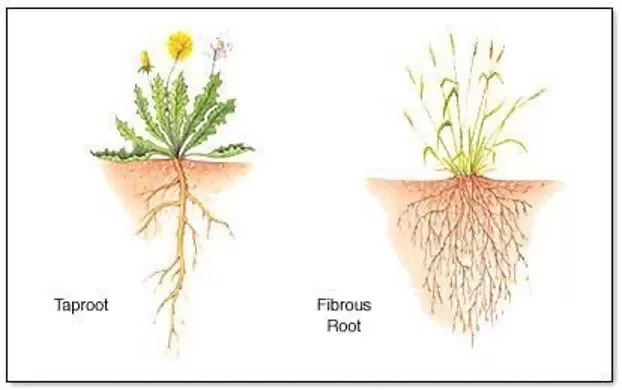
Post written by guest blogger Emily Grugan; Postbac IRTA fellow, OITE Summer Program Staff Assistant
Being a person who enjoys gardening (or, as it is currently in my life, taking care of plants in pots on shelves in my apartment), I recently found myself curious about the different types of root systems. From a quick Google search, I discovered that in general, plants have either taproot or fibrous root systems. Taproots are often deeper, stronger, and live longer, while fibrous roots tend to be smaller, weaker, and shorter-lived. In other words, a taproot plant is more firmly rooted and stable in the soil. (See the image above for visual examples of the two.)
Being a person who also appreciates a good metaphor, this struck me as a particularly versatile one. Bear with me as I explore a few of the possibilities here:
- Soil – Our environments: We, like plants in soil, are “potted” in our various environments – our workplaces, homes, and recreational areas, and the people they consist of
- Soil nutrients – Quality of our environments: Soil can be nutrient dense or deficient, fostering a respectively healthy or malnourished plant. Likewise, our environments can be those which nourish us (inspire us, propel us towards our professional goals, replenish our energy stores) or those which drain and deprive us. We might think of this as the amalgam of the tone and quality of the places in which we work/live/play and the interactions we have with people in them.
- Root type – Our stability: When a plant is of the taproot variety, it is more difficult to uproot; it is sturdier. Similarly, when we are in a stage of life in which we feel more stable, we too are at lower risk of being uprooted (emotionally overwhelmed, especially anxious, feeling out of control, etc.).
- Root strength – Adversity leads to growth: One example of a taproot plant is a tree. Trees need the adversity of strong winds to strengthen their roots. Without this, they will eventually fall for lack of support. Humans, too, are strengthened in the process of weathering storms – our resilience increases, we reinforce or adjust our values, we grow and learn, and we move (hopefully) from knowledge towards wisdom.
As I consider the health of each of the plants in my apartment, watering them every few days, keeping an eye on the coloring of their leaves, I find myself thinking about humans in a similar light. Perhaps it could be worthwhile every so often to assess the environments in which we have “potted” ourselves, and how they are affecting our sense of stability. Of course, the point of such an exercise would be to identify when an environmental factor (or its absence) might be imposing a negative influence, and then to adjust accordingly. But how? If only it were as simple as a little water and sunlight as in the case of our leafy friends. Although sometimes it might be. Seriously, try drinking a glass of water and sitting in the sun for a few minutes; you may find yourself feeling pretty plant-like after all. In the event that that isn’t enough, here are a few areas you could focus on:
Assess the health of your soil (your environment):
- Devote time to fostering positive social relationships (with friends, partners, family, etc.)
- Pursue a career field in which you share the values of others in it: If you haven’t found such a career already, consider meeting with a career counselor for guidance (*link to OITE career counselor scheduling page)
Assess the strength/quality of your roots: - Establish a daily routine: Maintain a consistent sleep schedule, healthy diet, and exercise routine. This allows for the development of a circadian rhythm, the health benefits of which abound.
- Determine a vision toward which to orient: Consider where you are headed. What would you like your life to be like in, for example, 3 years? Plan backwards from that and create a list of yearly, monthly, weekly, and daily goals by with you can accomplish your goals.




